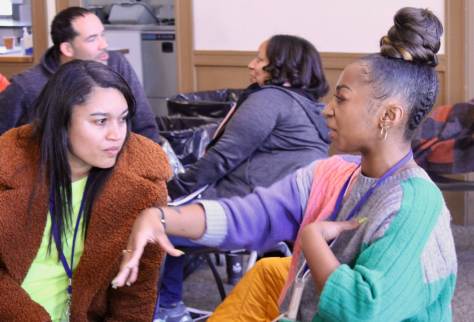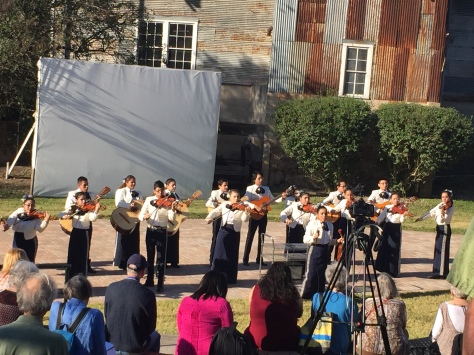Abolitionist teaching is built on the creativity, imagination, boldness, ingenuity, and rebellious spirit and methods of abolitionists to demand and fight for an education system where all students are thriving, not simply surviving.
-Bettina Love

The NDSG 2020 Chicago meeting opened by inviting all into the aims the planning committee outlined:
*Facilitate authentic, sustainable and healthy relationships through community building,
*Learn about, experience, and practice radical love and collective healing, and
*Develop a shared understanding of equity and collectively work within that framework.
Chicago teachers welcomed NDSG 2020 to Chicago with stories of struggle and resilience. They spoke of their love and dreams for their students. They shared their rage that the students aren’t ensured the resources they need to learn freely. Chicago teachers struck last fall, and they continue to push the city for critical resources like lower class sizes, mental health supports for students, and affordable housing. During the strike, teachers experienced the pain of separation from their students and of people in downtown offices who spit and cursed at them for striking. The Chicago teachers at NDSG wished NDSG folk had offered more support during that difficult time. The teachers asked the gathered educators to watch out for how the narratives of the powerful play out in Chicago, and to listen to the voices of students and teachers for the truth we need to hear.
The next morning, Kenwood Academy students came to perform spoken word and enter into conversation about their experiences in Chicago Public Schools. Before their performance, they joined the NDSG educators in exploring the meeting’s throughlines of radical love, racial justice, collective healing, and liberatory pedagogy through a Block Party process. An educator reflected on this session afterward as “a poignant way to engage artistic voice for consciousness raising in so many areas.” The quotes discussed in the Block Party process, she said, “were a good way to have interaction that set the stage for “receiving” the words of the youth by creating familiarity with each other.”
In the afternoon, Dr. David Stovall joined us to support our collective focus on race in NDSG. Underscoring the continuous nature of the fight for racial justice in our country and in our schools, in contrast to the occasional engagement of NDSG meetings, Dr. Stovall asked if this group is actually down to do the work. He set us up to move into our Racial Affinity Groups asking the question, “How are we living in recognition of our participation in or our refusal of white supremacy in our respective areas?” In the RAGs groups, which met three times over the course of the meeting, participants shared stories, questions, and challenges. A teacher wrote afterward, “the racial affinity group served as a release for healing collectively by sharing of the pains of systemic racism, within and outside NDSG.” Holding space for healing included challenging one another and ourselves to confront white supremacy as it impacted the spaces we shared in the past and share now in the present.
Another key part of building shared knowledge and healing was the panel discussion format. One panel, facilitated by Mara Sapon-Shevin, focused on the past, present, and future of NDSG, with speakers from different generations talking about the origins, long-time struggles, and achievements of NDSG, then current challenges, moving toward future possibilities. Deborah Meier attended the first NDSG meeting in 1972, when activists came together in North Dakota to resist standardized testing in HeadStart, and later, to talk about their work. Mary Harris and Jay Featherstone emphasized the importance of the arts and play in the meetings. Greta McHaney talked about the excitement, both loving and heated, of meetings where we deeply explored social issues and took action. Marsha Herron talked about the impact of the group on her life and of dreams for a more connected future, and Mia Valdez Quellhorst shared how NDSG has influenced her and her understanding of what it means to teach and to learn.
The other panel focused on Chicago and Jackson teachers, who in addition to meeting up at NDSG Jackson 2019 and 2018, built connections over the past three years through email and zoom calls sharing restorative practices, strategies for confronting the challenges of teaching in under-resourced schools, and teachers’ own life stories. Teachers on the panel included Carol Redfield-Mims, Rachael Nicholas, Yvette Vasquez, Martria Clifton, Stephanie Gates, and David Stieber, moderated by David Wasserman. The teachers didn’t talk about instilling knowledge in young people. They talked about their own learning, struggle, and solidarity. They told of the pain of losing students. With tremendous vulnerability, they identified a critical source of their anguish: the school system they are part of sets up the most vulnerable students for failure, prison, and death. What is education for, when the hard work and love of teachers, family members, and the students themselves isn’t enough to counter the systematic onslaught on Black bodies in this country?
In Home Groups, educators talked about what it means for Black students to matter, guided by passages from Bettina Love’s book We want to do more than survive. How do we stop perpetuating the harm on Black and Brown children that is built into the systems we’re part of? What would it look like for us to bring the focus we’re practicing here at NDSG, with our throughlines of radical love, collective healing, racial justice, and liberatory pedagogy, into our work in our respective spaces? These discussions deepened as together, we considered the video* of the Detroit-based Boggs School Principal, Julia Putnam, addressing how the school prepares students for the world we want to create.
Throughout the meeting, participants collectively sustained an intention to practice emergent strategy. We had read passages of Adrienne Maree Brown’s book Emergent Strategy in advance of the meeting, and were holding the intention of “moving at the speed of trust.” We were mindful of Brown’s guidance, “There is a conversation in the room that only these people in the room can have. Find it.” In this spirit, we sought to “build the resilience by building the relationships,” in traditional NDSG spaces like Home Groups, RAGs, Works in Progress, and Open Space Technology. We also made sure to have ample organized and unorganized Playtime and good food and drink, and grounded ourselves in the Love Pledge, in dancing, and in singing.
As the end of the meeting neared, we engaged in processes to help us think together about what the future might look like for NDSG. We collected into small groups through Open Space, and began sculpting some images of possible directions. These include centering youth leadership, fostering beloved community, critical revision of progressive education stances, engaging restorative processes, amplifying teachers’ stories, and digital community building. In closing, the group decided that NDSG should meet next year, should continue, and should develop ways of staying more connected and strategically organized over the course of the year. For example, educators might engage virtually in shared study over the course of the year, then convene in person at NDSG for broader cross-pollination and shaping new studies for the coming year.
NDSG closed with a ritual of interdependent wisdom. Participants committed to making the personal and collective changes needed for NDSG to deepen its anti-racist learning and to be centered in the leadership of people of color, and especially the leadership of young people of color. We look forward to organizing next steps toward these ends.
NDSG 2020 Photo Gallery, graciously offered by Phyllis Bretholtz
*Julia Putnam was the keynote speaker at the University of Michigan’s 2019 Martin Luther King Jr. Day Symposium. FULL VIDEO is here (Julia starts at 41:20). Enjoy!















